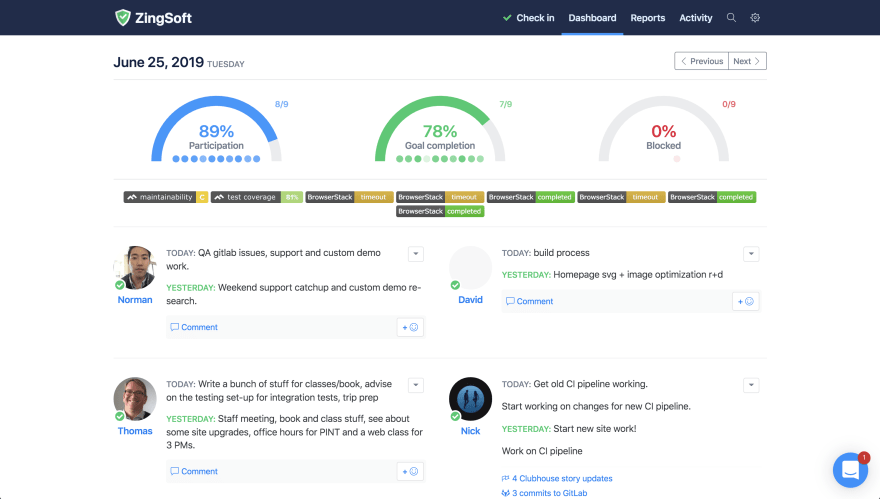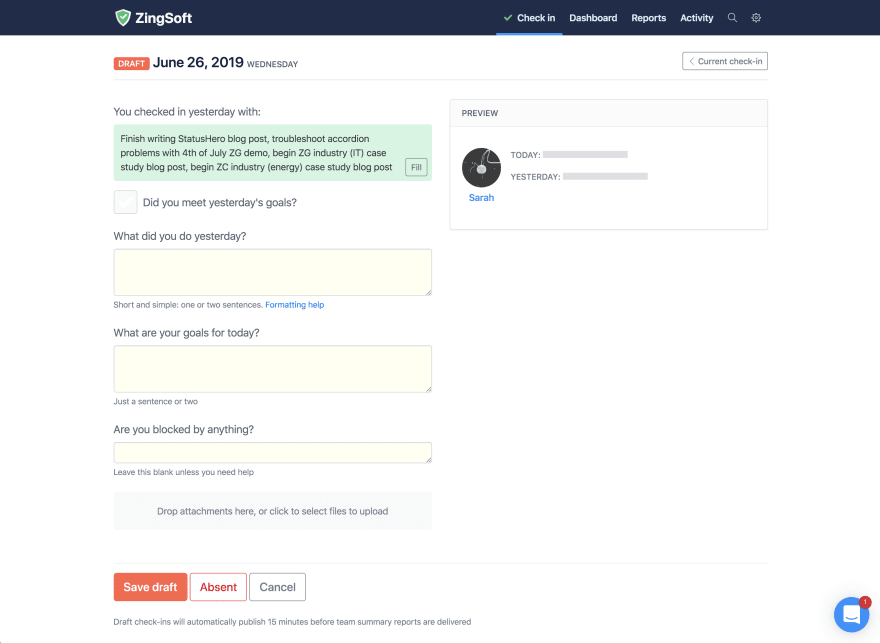Whether you're on a small development team, or are part of a much larger development organization, intra-team communication is vital regardless of your team's size. Yet given the increasing proliferation of digital communication tools and contexts in the modern workplace, that's easier said than done – especially during the ebb and flow of a busy workday.
At ZingSoft, we've been using a suite of popular tools for active communication with solid results for years, but more recently we realized we also had a passive communication problem. This distinction between active and passive communication patterns within teams is important for a few reasons. Whereas active communication is more immediate and direct (e.g. chat or email), passive communication is more persistent and indirect (e.g. status updates or a shared calendar).
Information can easily and quickly become buried when using active communication formats. In general, those conversational forms of communication aren't ideal for capturing and revisiting information like status updates or schedules. For example, relying solely on chat or face-to-face conversations can make it difficult for everyone to keep track of what everyone else on your team is doing within a given time period.
This is why StatusHero has become such an integral part of our team's daily workflow. It's a tool for tracking daily status updates and simple metrics around our team's daily goals, and it integrates well with tools we already use, like Gitlab and Clubhouse. Tried and true services like Slack, Gmail, and Zoom have been the workhorses of our digital interactions for years, but they're geared towards active, conversational communication formats.
In a workplace like ours where some teammates work remotely 100% of the time, while others split their time between in-office and remote work, the need for passive communication solutions like StatusHero becomes magnified. When your team's founder & CEO is also a computer science professor and soon-to-be data visualization professor, the need for those solutions becomes imperative.
So what does a status update look like? Every morning, everyone on the ZingSoft team receives a reminder via Slack to take a few minutes to fill out their StatusHero update for the day. A daily update involves succinctly answering four simple questions:
- Did you meet yesterday's goals?
- What did you do yesterday?
- What are your goals for today?
- Are you blocked by anything?
Every teammate's response is then displayed on a daily dashboard that chronicles a few simple metrics around team participation and goals, as well as everyone's status update for the day. This makes it easy to check in on what your team as a whole is doing on any given day, and also gives you the flexibility to go back as far as you need to if you'd like to see what someone was doing on a given day. Over time, you can begin to form a high-level picture of team health and productivity using StatusHero's Reports feature. With Reports, you can gauge team health over time based on comparisons like the proportion of daily goals hit versus days blocked.
Beyond the obvious benefits, StatusHero has helped increase our team's productivity in unexpected ways too. When it comes time to create presentations summarizing team activity over the course of the week or month (during retrospective or all-hands meetings, for example), StatusHero makes it so much easier to go back and summarize what everyone worked on. If I lose track of what I was working on due to a prolonged interruption, StatusHero makes it much quicker for me to re-orient myself in my workweek.
If you find that your development team could use some passive communication, then daily status updates are definitely a great place to start. Whether you go with StatusHero or a different type of solution, I highly recommend you explore how integrating more passive forms of communication into your team's daily workflow can increase productivity while helping your teammates feel better-informed.










Top comments (0)